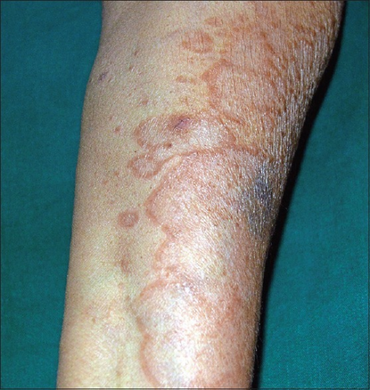Granuloma multiforme
Jump to navigation
Jump to search
| Granuloma multiforme | |
|---|---|
| Other names: Mkar disease and Granuloma multiforme (Leiker)[1] | |
 | |
| Polycyclic plaques with central clearing | |
Granuloma multiforme is a cutaneous condition most commonly seen in central Africa, and rarely elsewhere, characterized by skin lesions that are on the upper trunk and arms in sun-exposed areas.[2]: 707 It may be confused with tuberculoid leprosy, with which it has clinical similarities. The condition was first noted by Gosset in the 1940s, but it was not until 1964 that Leiker coined the term to describe "a disease resembling leprosy" in his study in Nigeria.[3]
See also
References
- ↑ Meyers, Wayne; Connor, DH; Shannon, R (January 1970). "Histologic characteristics of granuloma multiforme (Mkar disease). Including a comparison with leprosy and granuloma annulare. Report of first case from Congo (Kinshasa)". International Journal of Leprosy and Other Mycobacterial Diseases. 38 (3): 241–249. Archived from the original on 2022-03-18. Retrieved 2020-04-12.
- ↑ James, William D.; Berger, Timothy G.; et al. (2006). Andrews' Diseases of the Skin: clinical Dermatology. Saunders Elsevier. ISBN 978-0-7216-2921-6.
- ↑ Kumari, Rashmi; Devinder Mohan, Thappa; Chougule, Abhijit; Adityan, Balaji (2009). "Granuloma multiforme: A report from India". Indian Journal of Dermatology, Venereology and Leprology. 75 (3): 296–299. doi:10.4103/0378-6323.51259. PMID 19439886. Archived from the original on 2020-08-07. Retrieved 2020-04-12.
External links
| Classification |
|---|